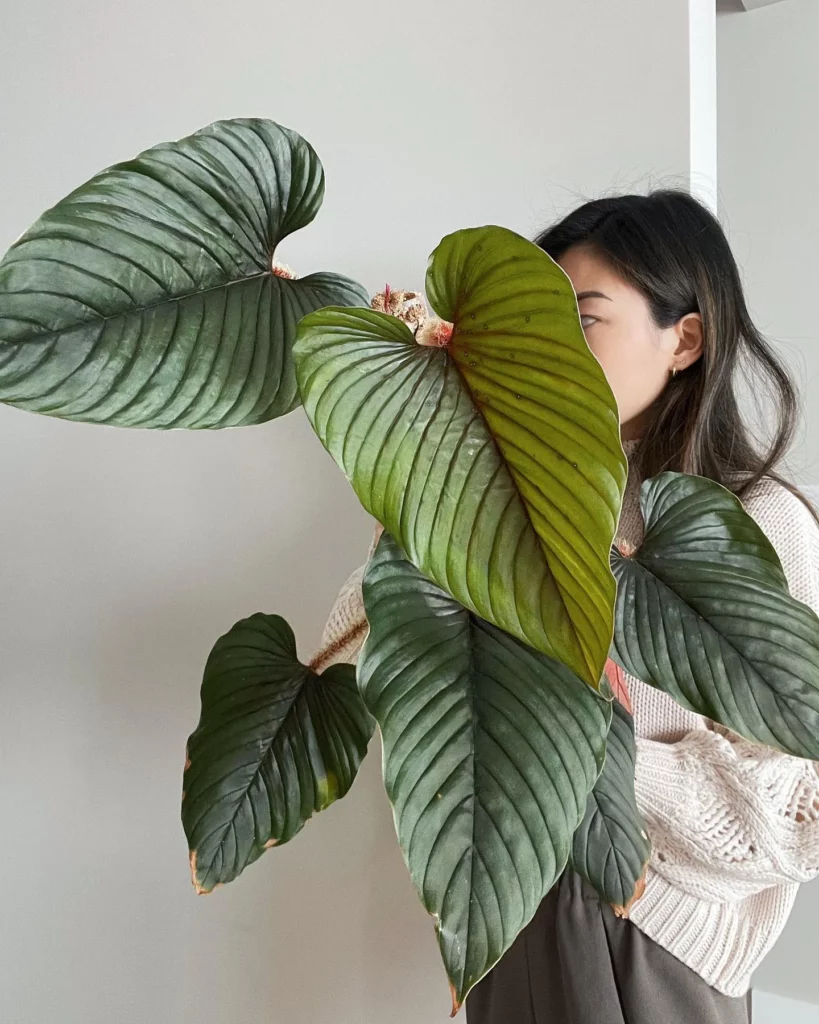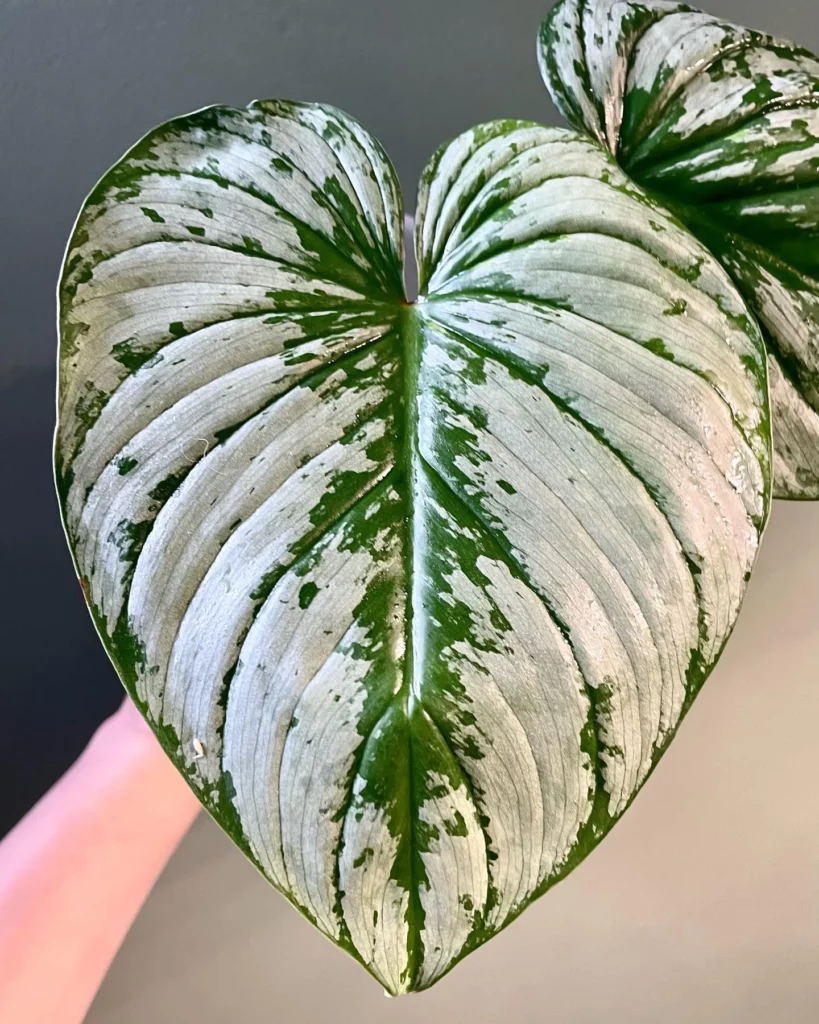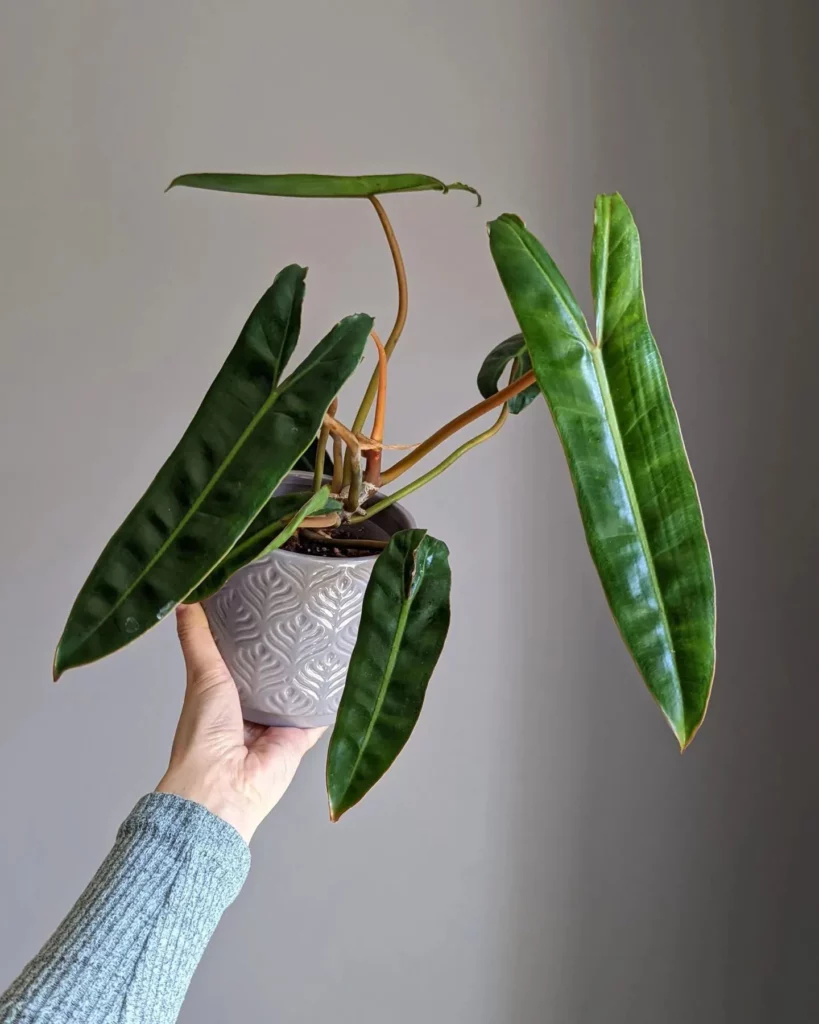Welcome to our comprehensive care guide for the Philodendron Serpens. If you’re looking to add a touch of lush beauty to your indoor jungle, this stunning plant is a must-have. With its glossy leaves and unique funky look, the Philodendron Serpens is sure to thrive in your home with a little bit of expert care. In this guide, you’ll find all the essential tips and tricks to nurture your Philodendron Serpens to perfection.
Key Takeaways:
- Philodendron Serpens is a gorgeous houseplant that adds elegance to any indoor jungle.
- It requires slightly moist soil and should be watered when the soil feels dry.
What Is Philodendron Serpens?



Philodendron serpens is a tropical plant that originated in South America. It belongs to the Araceae Juss plant family and is known for its large glossy leaves and funky-looking appearance. The name “serpens” comes from its serpent-like leafstalk and leaf shape. This plant is a unique addition to any indoor garden.
Watering Requirements



Proper watering is crucial for the health and well-being of your Philodendron serpens. To ensure optimal growth, it is important to understand its watering requirements.
Philodendron serpens thrives in slightly moist soil. You should water the plant when the soil feels dry to the touch. This allows the roots to absorb moisture without risking overwatering.
In the summer months, watering your Philodendron serpens every two or three days is usually sufficient. However, during the winter when the plant is in its dormant phase, watering once or twice a week is typically enough.
Keep a close eye on your plant for signs of underwatering or overwatering. Droopy leaves can indicate both conditions. If the leaves appear droopy, check the soil moisture level and adjust your watering accordingly.
Light Requirements



When it comes to caring for your Philodendron serpens, providing the right amount of light is crucial for its health and growth. This stunning plant thrives in bright indirect sunlight, so avoid placing it in direct sunlight, especially during the harsh noonday hours. Exposure to intense sunlight can lead to leaf burn and damage.
Instead, find a spot where your Philodendron serpens can receive bright, indirect light throughout the day. Placing it near a window that receives plenty of sunlight is ideal if you are growing it indoors. Make sure to rotate the plant periodically to ensure that all sides receive adequate sunlight. This practice not only helps in maintaining balanced growth but also prevents yellowing of the leaves.
If you notice that your plant is leaning or growing toward one direction, it may be an indication that it is not receiving enough light. In such cases, reposition the plant to a brighter spot to encourage even and healthy growth.
On the other hand, if you are growing your Philodendron serpens outdoors, make sure to provide a shade cloth or place it in an area with partial shade to protect it from intense sunlight. By finding the right balance of light, you can ensure that your Philodendron serpens remains vibrant and thriving.
Soil Requirements



Proper soil is essential for the healthy growth of your Philodendron serpens. This tropical plant thrives in well-draining soil that is neutral to slightly acidic. To create the ideal growing environment, follow these soil requirements:
Well-Draining Soil
Philodendron serpens prefers soil that allows excess water to flow away easily. It’s important to use a pot with multiple small holes at the bottom to ensure proper drainage. This helps prevent waterlogged soil, which can lead to root rot and other issues.
Neutral to Slightly Acidic Soil
When preparing the soil for your Philodendron serpens, aim for a neutral to slightly acidic pH level. This ranges from 6.0 to 7.0 on the pH scale. You can test the pH of your soil using a pH testing kit, which is available at most garden centers. Adjust the pH if necessary to provide the best growing conditions for your plant.
Perlite for Air Circulation
Incorporating perlite into the soil mixture can improve air circulation and prevent clumping. Perlite is a lightweight, volcanic rock material that helps create a loose and well-aerated soil structure. It allows the roots to access oxygen more easily and promotes healthy growth.
Coconut Coir for Moisture Retention
Adding coconut coir, a natural fiber derived from coconut husks, to the soil mix helps retain moisture without becoming waterlogged. Coconut coir has excellent water-holding capacity, ensuring that your Philodendron serpens receives sufficient moisture. It also provides good drainage, preventing the soil from becoming overly saturated.
Fertilizing Requirements



Proper fertilization is essential for the healthy growth and development of your Philodendron serpens. Understanding the fertilizing requirements of this beautiful houseplant will help you ensure its vitality and longevity.
Philodendron serpens benefits from fertilization every 3-4 months to provide it with the nutrients it needs to thrive. There are different types of fertilizers you can use, depending on your preference and availability.
A popular option is slow-release fertilizer or fertilizing beads, which gradually release nutrients over time. This helps prevent overfertilization and salt buildup, which can be harmful to the plant. Simply follow the instructions on the packaging to determine the appropriate amount of fertilizer to apply.
Alternatively, you can use an all-purpose NPK liquid fertilizer occasionally to give your Philodendron serpens a nutrient boost. This type of fertilizer contains a balanced blend of nitrogen (N), phosphorus (P), and potassium (K), which are essential for healthy plant growth.
When fertilizing your Philodendron serpens, it is important to apply the fertilizer as directed and avoid overfertilizing. Too much fertilizer can burn the plant’s roots and lead to nutrient imbalances. Always remember that moderation is key when it comes to fertilizing.
Temperature and Humidity Requirements



Philodendron serpens, also known as the Serpens Philodendron, thrives in temperatures ranging from 65 to 85 degrees Fahrenheit. To ensure its well-being, it’s important to keep the plant away from frosty weather as it is not frost-tolerant. In nature, these plants are found in tropical rainforests and warmer climes where higher humidity is prevalent.
The Philodendron serpens can adapt to varying levels of humidity, but it generally thrives in higher humidity environments. If you live in a region with lower humidity, you can provide extra moisture for your plant by using a humidifier or placing a pebble tray filled with water near it. These methods can help create a more humid microclimate around the plant, mimicking the conditions it would experience in its natural habitat.
Propagation Techniques



If you want to expand your collection of Philodendron serpens or share the joy of this beautiful plant with others, there are several propagation techniques you can try.
Stem Cutting
One of the most common propagation methods for Philodendron serpens is through stem cuttings. To propagate using this method, simply take a healthy stem cutting from the mother plant. Ensure that the cutting has several nodes, which are the points where leaves and branches emerge from the stem. Remove any leaves from the lower part of the cutting and place it in a glass of water or well-draining soil. Keep the cutting in a warm and bright location, and within a few weeks, you should start to see roots forming. Once the roots are about an inch long, you can transplant the cutting into its own pot.
Air Layering
Another propagation technique for Philodendron serpens is air layering. To use this method, select a healthy stem on the mother plant. Make a small incision just below a node, and wrap the area with damp sphagnum moss. Cover the moss with plastic wrap to create a moist and humid environment. After a few weeks, you should see roots forming. Once the roots are well-established, you can carefully cut the stem below the air layer and pot it up as a new plant.
Seed Propagation
While less commonly used, Philodendron serpens can also be propagated from seeds. Collect mature seeds from the plant and sow them in a well-draining potting mix. Keep the soil consistently moist and place the pot in a warm, bright location. Germination can take several weeks to months, so be patient. Once the seedlings have developed a few true leaves, you can transplant them into individual pots.
Growth and Development


Philodendron serpens is a slow-growing vining plant that can bring a touch of natural beauty to your indoor space. With its glossy leaves and fuzzy petioles, this plant is sure to catch the eye and add a unique touch to your home or office décor.
While the growth rate of Philodendron serpens may vary, it typically reaches heights of up to 12 inches. Its slow-growing nature allows you to enjoy the development and transformation of the plant over time, making it a delightful addition to any plant enthusiast’s collection.
As the plant grows, it produces new leaves that unfurl and showcase their glossy beauty. The vining habit of Philodendron serpens offers an opportunity for creative placement, whether displayed on a tabletop or allowed to cascade down from a hanging basket.
To ensure the optimal growth and development of your Philodendron serpens, it is essential to provide it with the right care and attention. By maintaining the appropriate watering, light, and temperature conditions, as well as regular fertilization, you can nurture this slow-growing plant into a lush and thriving centerpiece of your indoor garden.
Pests and Diseases
Just like any other plant, Philodendron serpens is susceptible to pests and diseases. It’s important to be aware of these common issues and take proactive measures to protect your plant’s health.
Pests:
Two common pests that can affect Philodendron serpens are mealybugs and thrips. Mealybugs are small, white, cotton-like insects that can gather on the leaves and stems of your plant.
Thrips, on the other hand, are tiny, slender insects that can cause damage by feeding on the plants’ tissues.
To prevent these pests from infesting your Philodendron serpens, regularly inspect your plant for any signs of infestation, such as white cotton-like spots, small insects, or distorted leaves. If you notice any signs, take immediate action to treat the infestation.
Diseases:
Overwatering can lead to root rot in Philodendron serpens. This occurs when the roots of the plant are constantly saturated, leading to the decay of the root system.
Bacterial infections can also occur in Philodendron serpens if the plant is exposed to excessive moisture or if there are wounds on the leaves or stems.
To prevent root rot and bacterial infections, be cautious about watering your plant. Ensure that the soil is well-drained and allow it to dry out between waterings. Avoid overwatering, and consider using a well-draining soil mix.
Maintaining good hygiene is also crucial. Remove any dead or decaying plant matter from the vicinity of your Philodendron serpens, as it can attract pests and diseases.
Varieties of Philodendron
Philodendron serpens, a popular houseplant, offers enthusiasts the opportunity to explore a few delightful variations beyond its standard form. Among these varieties are the Philodendron Serpens Chocolate and Philodendron Serpens × Verrucosum. While these variations may possess slightly different characteristics and appearances, they generally share the same care requirements as the standard Philodendron serpens.
Philodendron Serpens Chocolate, as its name suggests, adds a touch of richness to your indoor jungle with its deep, chocolatey tones. This variety presents velvety green leaves infused with shades of dark brown, creating a captivating aesthetic for any plant collection. The Philodendron Serpens × Verrucosum, on the other hand, displays striking foliage characterized by its mottled appearance, boasting a unique combination of textures and colors.
Whether you choose the Philodendron Serpens Chocolate or the Philodendron Serpens × Verrucosum, both variations promise to bring beauty and sophistication to your space. Remember to provide them with the same level of care and attention as their parent plant, including proper watering, lighting, and fertilization, to ensure their continued health and vitality.
FAQ
What is Philodendron Serpens?
Philodendron Serpens is a tropical plant that originated in South America. It belongs to the Araceae Juss plant family and is known for its large glossy leaves and funky-looking appearance. The name “serpens” comes from its serpent-like leafstalk and leaf shape. This plant is a unique addition to any indoor garden.
How often should I water Philodendron Serpens?
Philodendron Serpens requires slightly moist soil. It is important to water this plant when the soil feels dry to the touch. In the summer, watering every two or three days is usually sufficient. During the winter, watering once or twice a week is typically enough. Overwatering can lead to root rot, so it is important to avoid allowing the plant to sit in water.
What are the light requirements for Philodendron Serpens?
Philodendron Serpens thrives in bright indirect sunlight. It is important to keep the plant away from harsh noonday sun to prevent leaf burn. Rotating the plant periodically ensures that all sides receive adequate sunlight and prevents yellowing of the leaves. If growing indoors, placing the plant near a window that receives lots of sunlight is ideal.
What type of soil does Philodendron Serpens need?
Philodendron Serpens requires well-draining soil that is neutral to slightly acidic. Using a pot with multiple small holes at the bottom and a tray to collect excess water helps ensure proper drainage. The soil should contain perlite to prevent clumping and allow for good air circulation, and adding coconut coir helps retain the right amount of moisture.
How often should I fertilize Philodendron Serpens?
Philodendron Serpens benefits from fertilization every 3-4 months. Using a slow-release fertilizer or fertilizing beads prevents overfertilization and salt buildup, which can be detrimental to the plant. Occasionally, using an all-purpose NPK liquid fertilizer is also an option. It is important to follow the instructions on the fertilizer packaging and avoid overfertilizing.
What temperature and humidity levels does Philodendron Serpens prefer?
Philodendron Serpens prefers temperatures ranging from 65 to 85 degrees Fahrenheit. It is important to keep the plant away from frosty weather as it is not frost-tolerant. Philodendron Serpens can adapt to varying levels of humidity, but it generally thrives in higher humidity. Providing extra humidity through the use of a humidifier or pebble tray can benefit the plant’s growth.
How can I propagate Philodendron Serpens?
Philodendron Serpens can be propagated through stem cuttings, air layering, or seed propagation. Stem cuttings can be taken and rooted in water or soil. Air layering involves making a cut in the stem and promoting root growth using moss and plastic wrap. Seed propagation, while less common, is also an option for propagating Philodendron Serpens.
How does Philodendron Serpens grow and develop?
Philodendron Serpens is a slow-growing plant that can eventually reach heights of up to 12 inches. It is a vining plant that produces glossy leaves and has fuzzy petioles. The plant’s growth rate may vary, but with proper care and attention, it can develop into a lush and beautiful addition to your indoor garden.
What pests and diseases should I watch out for with Philodendron Serpens?
Philodendron Serpens can be susceptible to pests such as mealybugs and thrips. Regularly inspecting the plant for signs of infestation, such as white cotton-like spots or small insects, is important for early detection and treatment. Overwatering can lead to root rot, and bacterial infections can also occur. Proper watering and maintaining good hygiene can help prevent these issues.
Are there different varieties of Philodendron Serpens?
Yes, there are some varieties of Philodendron Serpens, including Philodendron Serpens Chocolate and Philodendron Serpens × Verrucosum. These variations may exhibit slightly different characteristics but generally fall within the same care requirements as the standard Philodendron Serpens.




